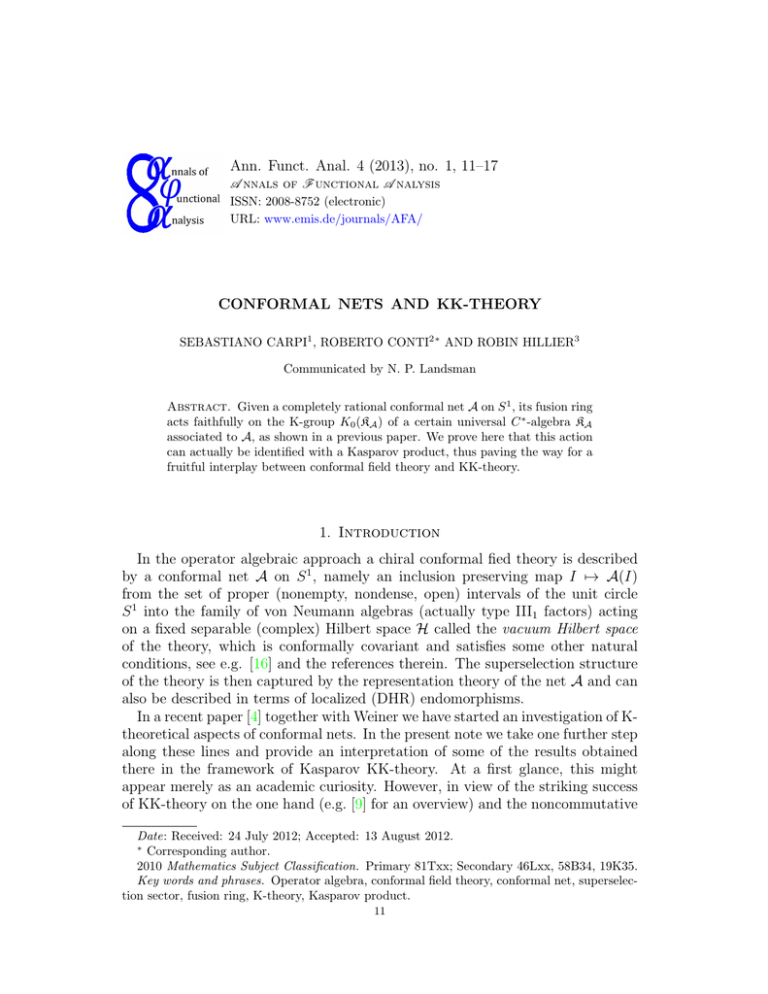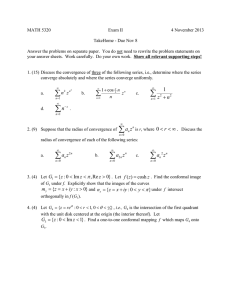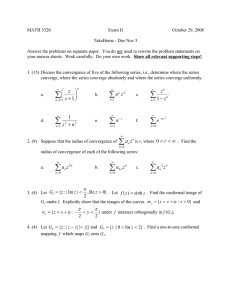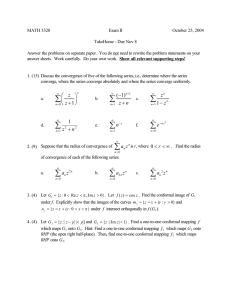Ann. Funct. Anal. 4 (2013), no. 1, 11–17
advertisement

Ann. Funct. Anal. 4 (2013), no. 1, 11–17
A nnals of F unctional A nalysis
ISSN: 2008-8752 (electronic)
URL: www.emis.de/journals/AFA/
CONFORMAL NETS AND KK-THEORY
SEBASTIANO CARPI1 , ROBERTO CONTI2∗ AND ROBIN HILLIER3
Communicated by N. P. Landsman
Abstract. Given a completely rational conformal net A on S 1 , its fusion ring
acts faithfully on the K-group K0 (KA ) of a certain universal C ∗ -algebra KA
associated to A, as shown in a previous paper. We prove here that this action
can actually be identified with a Kasparov product, thus paving the way for a
fruitful interplay between conformal field theory and KK-theory.
1. Introduction
In the operator algebraic approach a chiral conformal fied theory is described
by a conformal net A on S 1 , namely an inclusion preserving map I 7→ A(I)
from the set of proper (nonempty, nondense, open) intervals of the unit circle
S 1 into the family of von Neumann algebras (actually type III1 factors) acting
on a fixed separable (complex) Hilbert space H called the vacuum Hilbert space
of the theory, which is conformally covariant and satisfies some other natural
conditions, see e.g. [16] and the references therein. The superselection structure
of the theory is then captured by the representation theory of the net A and can
also be described in terms of localized (DHR) endomorphisms.
In a recent paper [4] together with Weiner we have started an investigation of Ktheoretical aspects of conformal nets. In the present note we take one further step
along these lines and provide an interpretation of some of the results obtained
there in the framework of Kasparov KK-theory. At a first glance, this might
appear merely as an academic curiosity. However, in view of the striking success
of KK-theory on the one hand (e.g. [9] for an overview) and the noncommutative
Date: Received: 24 July 2012; Accepted: 13 August 2012.
∗
Corresponding author.
2010 Mathematics Subject Classification. Primary 81Txx; Secondary 46Lxx, 58B34, 19K35.
Key words and phrases. Operator algebra, conformal field theory, conformal net, superselection sector, fusion ring, K-theory, Kasparov product.
11
12
S. CARPI, R. CONTI, R. HILLIER
geometrization program for (super-) conformal nets and their representations
[19, 6, 5] on the other hand, we feel that there are good reasons to give a closer
look at this subject, as it could possibly reveal a lot of potential for further
investigations.
We recall the results in [4] relevant for the present analysis, referring the reader
to that paper for more details, notation, and references. Let A be a completely
rational local conformal net on S 1 . We can then define the so-called locally normal
∗
universal C ∗ -algebra Cln
(A) which is canonically associated to the superselection
theory of the net. It may be expressed as a quotient of the universal algebra C ∗ (A)
previously defined by Fredenhagen in [12] or, equivalently, as the image of C ∗ (A)
in the so-called locally normal universal representation (πln , Hln ). The surprising
∗
(A) turns out to be isomorphic to the direct sum B(H)⊕n of n
fact is that Cln
copies of the algebra B(H) of all bounded operators on the vacuum Hilbert space
of A. Here, n < ∞ is the number of sectors of A. Consequently, it has trivial
K-theory and several other properties which do not make it really attractive as a
C ∗ -algebra.
We therefore consider its separable C ∗ -subalgebra KA generated by the finite
projections. It is isomorphic to K⊕n ⊂ B(H)⊕n , where K := K(H) is the algebra
∗
of compact operators on H. Clearly KA is an ideal of Cln
(A) and in fact it is the
largest among the norm-separable ideals. We have
K0 (KA ) = Zn ,
K1 (KA ) = 0.
Furthermore, we get a faithful semiring action of the fusion semiring RA of A
∗
on K0 (KA ), via restriction of endomorphisms of Cln
(A) to KA and subsequent
pushforward to K0 (KA ). Namely, as shown in [4, Th.4.4], there is an injective
semiring homomorphism
η : RA → End(K0 (KA ))
satisfying η[ρ] = (ρ̂|KA )∗ for every localized covariant endomorphism ρ of C ∗ (A),
where [ρ] ∈ RA is the sector (i.e., the unitary equivalence class) represented
∗
by ρ, and ρ̂ is a normal *-homomorphism of Cln
(A) naturally associated to ρ,
mapping KA into itself. Hereafter, we shall use “[ρ]“ exclusively to denote the
sector determined by ρ and not its KK-class.
We shall give an interpretation of this action in terms of KK-theory. This fact
can be seen as an illustration in the conformal nets setting of a comment of Izumi
[13, page 118], based on previous ideas of Kajiwara and Watatani [15, 21], on the
relation between sector theory and KK-theory. There they work out the most
natural way of associating a KK-class to a *-homomorphism between two simple
C ∗ -algebras. In our context, however, it is a priori unclear what are the correct
C ∗ -algebras to be considered and whether we can get rid of their assumptions.
In [10, 11], Evans and Gannon discuss KK-theoretical aspects of CFT in relation
to modular invariants and twisted K-theory. Following some of their ideas, we
shall provide a KK-theoretical interpretation of modular invariants in our setting
towards the end of the present article.
Another instance of the emergence of KK-theoretical concepts in AQFT has
been recently pointed out by Conti and Morsella [7], where the DHR sectors of
CONFORMAL NETS AND KK-THEORY
13
scaling limit nets (as defined by Buchholz-Verch, in order to cast the renormalization group analysis into operator algebraic terms) are described by maps of
the original global quasi-local C ∗ -algebra on four-dimensional Minkowski spacetime that are suitable modifications of the asymptotic morphisms of Connes and
Higson.
We close this introduction by mentioning that other relationships of seemingly
quite different nature between KK-theory and quantum field theory have been
investigated by other authors, see e.g. [3].
2. Basics of KK-theory
It is well-known that the push-forward of *-homomorphisms gives rise to elements in KK-theory. We want to see how this works in our setting in relation
to the semiring action η recalled above. For the convenience of the reader and
in order to fix the notation let us introduce here KK-theory very briefly, while
referring to [1] and [14] for details. All C ∗ -algebras we consider below will be
separable and stably unital. In particular, the various approaches to KK-theory
become all equivalent [1, Sec.17&18] and K0 (A) is the Grothendieck group of
the projection semigroup of the C ∗ -algebra K ⊗ A. Moreover, we will restrict
ourselves to the ungraded algebra case.
A Kasparov (A, B)-module is a tuple (E, φ, F ), where E is a countably generated
graded Hilbert B-module, φ : A → B(E) is a graded *-homomorphism, and
F ∈ B(E) has degree one, such that
(F − F ∗ )φ(a),
(F 2 − 1)φ(a),
[F, φ(a)]
lie all in K(E), the compact operators on E, for all a ∈ A. With the usual concept
of homotopy, one defines KK(A, B) as the set of homotopy equivalence classes
of Kasparov (A, B)-modules. Moreover, if we have two Kasparov (A, B)-modules
(Ei , φi , Fi ) and a unitary in B(E1 , E2 ) intertwining the φi and the Fi , then the
two Kasparov modules are homotopically equivalent. There is a direct sum for
Kasparov (A, B)-modules, which passes to the quotient KK(A, B); cf. [1, Sec.17]
for all these statements.
For our immediate purposes, the most relevant facts about KK-theory can be
summarized as follows:
Theorem 2.1. Let A, B, C be C ∗ -algebras as above.
(1) KK(A, B) is an abelian group with respect to the above addition, and
KK is a bifunctor from the category of C ∗ -algebras to abelian groups [1,
17.3&17.8].
(2) There is a canonical identification of KK(C, A) with K0 (A) (as additive
groups), [1, 17.5.5].
(3) Every *-homomorphism φ : A → B naturally defines a KK(A, B)-element
{φ} as the homotopy class of (B, φ, 0), where we have identified B(B) with
the multiplier algebra M(B).
(4) If two *-homomorphisms φ, ψ : A → B, are unitarily equivalent in M(B),
then the induced KK(A, B)-elements coincide, [14, Sec.1.3].
14
S. CARPI, R. CONTI, R. HILLIER
(5) There exists a bilinear map ×, the so-called Kasparov product
KK(A, B) × KK(B, C) → KK(A, C),
which is associative, [1, Sec.18].
(6) If ψ : A → B and φ : B → C are *-homomorphisms then
{ψ} × {φ} = {φ ◦ ψ}.
If idA is the identity automorphism of A then {idA } is the neutral element
in KK(A, A) for the Kasparov product. Hence KK(A, A) is a unital ring.
(7) The adjoint of the pairing KK(C, A) × KK(A, B) → KK(C, B) defines,
via the identification in (2), a map γ : KK(A, B) → Hom(K0 (A), K0 (B)),
namely
γ(y)(x) = x × y,
x ∈ K0 (A), y ∈ KK(A, B).
For y = {φ} with φ : A → B a *-homomorphism, we have
γ({φ}) = φ∗ ,
the push-forward of φ in K-theory.
We only mention that property (6) may be obtained as a consequence of the
functoriality properties of the KK-product [1, 18.7.1] and the relation {φ} =
φ∗ {idC }. The canonical identification in (2) is given by
i
h
0 1
∈ KK(C, A),
[p+ ] − [p− ] ∈ K0 (A) 7→ HA ⊕ HA , φp+ ⊕ φp− ,
1 0
where HA is the Hilbert module A ⊗ l2 (Z), the grading on HA ⊕ HA is 1 ⊕ −1,
p± ∈ A ⊗ K are projections, and φp± is the map: t ∈ C 7→ tp± ∈ M(A ⊗ K).
It has, in particular, the property that push-forwards in K0 (A) and KK(C, A)
mutually correspond to each other. All this can be easiest seen as outlined in
[8, Sec.1] following Cuntz’ quasi-homomorphism picture; alternatively one may
use [1, 17.5.5]. Finally, property (7) is a consequence of (2) and the functoriality
property [1, 17.8.2].
3. Main result
Let us return to our setting, using the notation from the above theorem and
Section 4 in [4].
Theorem 3.1. Let A be a completely rational net on S 1 , and let η : RA →
End(K0 (KA )) be the injective semiring homomorphism recalled above. Then there
is an injective unital semiring homomorphism j : RA → KK(KA , KA ) such that
x × j([ρ]) = η[ρ] (x),
[ρ] ∈ RA , x ∈ K0 (KA ) = KK(C, KA ).
(3.1)
Proof. Using Theorem 2.1(1), define
j([ρ]) := {ρ̂|KA } ∈ KK(KA , KA ), [ρ] ∈ RA .
This map is well-defined since if ρ and ρ0 are equivalent endomorphisms in C ∗ (A)
∗
then ρ̂ and ρ̂0 are equivalent endomorphisms of Cln
(A). As the latter contains KA
as an ideal and it is weakly closed in B(Hln ), it can be easily identified with the
CONFORMAL NETS AND KK-THEORY
15
multiplier algebra M(KA ). Then by Theorem 2.1(2), ρ̂|KA and ρ̂0 |KA give rise to
Kasparov (KA , KA )-modules, which according to (3) are equivalent and so define
the same KK-element {ρ̂|KA }.
Furthermore, j is multiplicative, namely j([ρ1 ][ρ2 ]) = j([ρ1 ])×j([ρ2 ]) and j([id])
is the unit in KK(KA , KA ). Indeed, using the commutativity of the composition
of DHR sectors (due to the existence of a unitary braiding) and point (6) in
Theorem 2.1,
j([ρ1 ][ρ2 ]) = j([ρ1 ◦ ρ2 ]) = j([ρ2 ◦ ρ1 ]) = {ρ\
2 ◦ ρ1 |KA }
= {ρˆ2 |KA ◦ ρˆ1 |KA } = {ρˆ1 |KA } × {ρˆ2 |KA } = j([ρ1 ]) × j([ρ2 ]) .
Next, we check additivity of j, namely j([ρ1 ] ⊕ [ρ2 ]) = j([ρ1 ]) + j([ρ2 ]). If
s1 and s2 are a pair of isometries generating a copy of O2 inside C ∗ (A) then a
representative of [ρ1 ] ⊕ [ρ2 ] ∈ RA is the endomorphism ρ = s1 ρ1 (·)s∗1 + s2 ρ2 (·)s∗2 .
∗
Therefore, using the fact that ρ̂(x) = ŝ1 ρˆ1 (x)ŝ∗1 + ŝ2 ρˆ2 (x)ŝ∗2 , x ∈ Cln
(A), where
sˆi = πln (si ), i = 1, 2, one has
j([ρ1 ] ⊕ [ρ2 ]) = {(s1 ρ1 (·)s∗1 + s2 ρ2 (·)s∗2 )ˆ|KA } = {ŝ1 ρˆ1 |KA ŝ∗1 + ŝ2 ρˆ2 |KA ŝ∗2 } .
∗
The subsequent Lemma 3.2 and its proof (with A = Cln
(A) and I = KA ) imply
T (KA ⊕ KA ) = KA ,
T (ρˆ1 |KA ⊕ ρˆ2 |KA )T ∗ = ŝ1 ρˆ1 |KA ŝ∗1 + ŝ2 ρˆ2 |KA ŝ2 ,
so that, according to Theorem 2.1(3) and the introduction of Kasparov modules,
the classes of (KA , ρˆ1 |KA , 0) ⊕ (KA , ρˆ1 |KA , 0) and (KA , ŝ1 ρˆ1 |KA ŝ∗1 + ŝ2 ρˆ2 |KA ŝ∗2 , 0) in
KK(KA , KA ) coincide, thus
{ŝ1 ρˆ1 |KA ŝ∗1 + ŝ2 ρˆ2 |KA ŝ∗2 } = {ρˆ1 |KA } + {ρˆ2 |KA } = j([ρ1 ]) + j([ρ2 ]).
Finally, identity (3.1) follows at once from point (7) in Theorem 2.1. Since η is
injective according to [4, Theorem 4.4], j has to be injective, too.
Lemma 3.2. Let A be a unital C ∗ -algebra containing a copy of the Cuntz algebra
O2 and let I be a closed two-sided ideal in A. Then I ⊕ I ' I as right Hilbert
I-modules.
Proof. Let s1 , s2 ∈ A be a pair of isometries such that s1 s∗1 + s2 s∗2 = 1. Define
the linear operator T : I ⊕ I → I by T (a, b) := s1 a + s2 b, a, b ∈ I. It is easy to
see that T is an isometric and surjective right I-module map, so that it is indeed
unitary, [18, 3.2].
4. Some remarks
First of all, Theorem 3.1 says that the left action of RA on K0 (KA ) “factorizes”
through a right action of KK(KA , KA ) and can be expressed in terms of a Kasparov product. This construction appears to depend on various special properties
of the algebra KA which has been defined only for completely rational conformal
nets. It is not evident how to generalize the definition of KA in order to find the
16
S. CARPI, R. CONTI, R. HILLIER
analogues of [4, Th.4.4] and Theorem 3.1 for a more general class of conformal
nets.
Second, write R̃A for the Grothendieck ring generated by the semiring RA and
j̃ for the unique ring homomorphism extending j to R̃A . It is clearly injective,
owing to the preceding theorem. We would like to stress then that j̃(R̃A ) ⊂
KK(KA , KA ) is always a proper subring if the number of sectors n is greater
than 1, i.e., for non-holomorphic theories. This can be easily seen because R̃A '
K0 (KA ) is commutative while KK(KA , KA ) is non-commutative. To prove the
latter statement, we simply apply the universal coefficient theorem [2, V.1.5.8],
which holds for the algebra KA since it lies in the so-called bootstrap class [2,
V.1.5.4], and which says
KK(KA , KA ) ' End(K0 (KA )) ' Mn (Z).
Our last comment concerns modular invariants. In [10, Sec.7] it has been
pointed out that modular invariants can be regarded as certain KK-classes. As
we shall see now, an interpretation of modular invariants as KK-classes can be
directly formulated in our setting. For a completely rational conformal net the
braiding is always non-degenerate [17, Cor.37]. Then by Rehren’s construction
there are invertible complex vector space endomorphisms S, T ∈ End(C ⊗Z R̃A )
giving rise to a representation of the modular group SL(2, Z) on the fusion algebra
C ⊗Z R̃A , cf. [20]. A modular invariant is a Z-module endomorphisms Z ∈
EndZ (R̃A ) such that:
- id ⊗Z Z ∈ End C ⊗Z R̃A commutes with S and T (modular invariance);
- Z(RA ) ⊂ RA (positivity);
- the matrix element Z11 in the distinguished basis of sectors is 1 (uniqueness of the vacuum).
Hence, as a consequence of the additive group isomorphism R̃A ' K0 (KA ), every modular invariant Z can be identified with an element in End(K0 (KA )) '
KK(KA , KA ).
Acknowledgement. We would like to thank Roberto Longo for stimulating
comments on the relationship between the the representation theory of conformal
nets and KK-theory. We also thank Martin Grensing for a very useful discussion
on Kasparov products and for drawing to our attention some references.
References
1. B. Blackadar, K-theory for operator algebras, 2nd edition, Mathematical Sciences Research
Institute Publications 5, Cambridge University Press, Cambridge, 1998.
2. B. Blackadar, Operator algebras. Theory of C ∗ -algebras and von Neumann algebras, Encyclopaedia of Mathematical Sciences, 122, Operator Algebras and Non-commutative Geometry, III, Springer-Verlag, Berlin, 2006.
3. J. Brodzki, V. Mathai, J. Rosenberg and R. Szabo, D-branes, RR-fields and duality on
noncommutative manifolds, Comm. Math. Phys. 277 (2008), 643–706.
4. S. Carpi, R. Conti, R. Hillier and M. Weiner, Representations of conformal nets, universal
C ∗ -algebras and K-theory, Commun. Math. Phys. DOI: 10.1007/s00220-012-1561-5.
CONFORMAL NETS AND KK-THEORY
17
5. S. Carpi, R. Hillier, Y. Kawahigashi and R. Longo, Spectral triples and the super-Virasoro
algebra, Comm. Math. Phys. 259 (2010), 1–27.
6. S. Carpi, Y. Kawahigashi and R. Longo, Structure and classification of superconformal nets,
Ann. Henri Poincaré 9 (2008), 1069–1121.
7. R. Conti and G. Morsella, Asymptotic morphisms and superselection theory in the scaling
limit, J. Noncommut. Geom. (to appear), arXiv: 1205.6380.
8. J. Cuntz, Generalized homomorphisms between C ∗ -algebras and KK-theory, Dynamics and
processes, 31–45, LNM 1031, Springer, Berlin, 1983.
9. J. Cuntz, R. Meyer and J.M. Rosenberg, Topological and bivariant KK-theory, Oberwolfach
Seminars, 36, Birkhäuser Verlag, Basel, 2007.
10. D.E. Evans and T. Gannon, Modular invariants and twisted K-theory, Commun. Number
Theory Phys. 277 (2009), 209–296.
11. D.E. Evans and T. Gannon, Modular invariants and twisted K-theory II. Dynkin diagram
symmetries, arXiv:1012.1634.
12. K. Fredenhagen, Generalizations of the theory of superselection sectors, The algebraic theory of superselection sectors. Introduction and recent results (Palermo, 1989), 379-–387,
World Sci. Publ., River Edge, NJ, 1990.
13. M. Izumi, Inclusions of simple C ∗ -algebras, J. Reine Angew. Math. 547 (2002), 97–138.
14. K.K. Jensen and K. Thomsen. Elements of KK-theory, Birkhäuser, Boston, MA, 1991.
15. T. Kajiwara and Y. Watatani, Jones index theory by Hilbert C ∗ -bimodules and K-theory,
Trans. Amer. Math. Soc. 352 (2000), 3429–3472.
16. Y. Kawahigashi and R. Longo, Classification of local conformal nets. Case c < 1, Ann. of
Math. 160 (2004), 493–522.
17. Y. Kawahigashi, R. Longo and M. Müger, Multi-interval subfactors and modularity of representations in conformal field theory, Comm. Math. Phys. 219 (2001), 631–669.
18. E.C. Lance. Hilbert C ∗ -modules. A toolkit for operator algebraists, London Mathematical
Society Lecture Note Series, 210. Cambridge University Press, Cambridge, 1995.
19. R. Longo. Notes for a quantum index theorem. Comm. Math. Phys. 222 (2001), 45–96.
20. K.H. Rehren, Braid group statistics and their superselection rules, The algebraic theory
of superselection sectors. Introduction and recent results (Palermo, 1989), 333–355, World
Sci. Publ., River Edge, NJ, 1990.
21. Y. Watatani, Index for C ∗ -subalgebras. Mem. Amer. Math. Soc. 83, 1990.
1
Dipartimento di Economia, Università di Chieti-Pescara “G. d’Annunzio”
Viale Pindaro, 42, I-65127 Pescara, Italy.
E-mail address: s.carpi@unich.it
2
SBAI, Sezione di Matematica, Sapienza Università di Roma, Via A. Scarpa,
16, I-00161 Roma, Italy.
E-mail address: roberto.conti@sbai.uniroma1.it
3
Dipartimento di Matematica, Università di Roma “Tor Vergata”, Via della
Ricerca Scientifica, 1, I-00133 Roma, Italy.
E-mail address: hillier@mat.uniroma2.it






